Despite being an undeniably flatwater race (I measured) during ocean racing season, the Great Stone Dam Classic has become an essential stop in the New England surfski circuit. Hosted by the Greater Lawrence Community Boating Program, co-chaired by Francisco Urena and Shawn Burke, and staffed largely by an enthusiastic army of student volunteers, it’s no secret why the GSDC has become such a favorite. Sure, it’s an appealing venue – a magnificent boathouse set on the verdant shores of the Merrimack River. And yes, participants enjoy the warm glow that comes from helping to fund a wonderful youth program. The real reason most of us show up, however, is our shared respect and esteem for Francisco. And by “respect and esteem” I mean, of course, “fear”. After all, Francisco has some very powerful friends. Skip this race and you just might wake up one night to find Governor Baker preparing to smother you with a pillow.
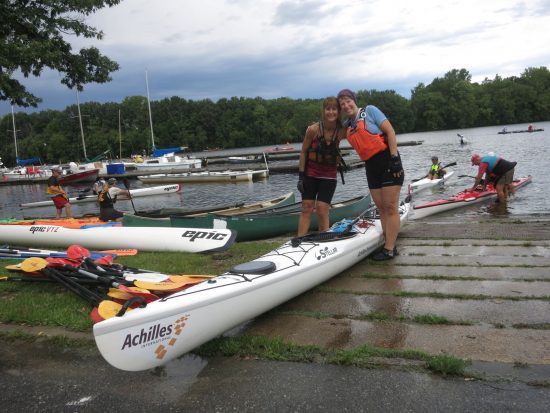
Robin was quite tolerant of Mary Beth in the tandem, despite the fact that (based on first-hand K2 experience from our past) she consistently does everything completely wrong.
The GSDC is a classic out-and-not-quite-back-and-out-and-over-and-back course totaling 8.2 miles. From the boathouse dock, we head upriver 3 miles to turn around Pine Island, then return towards to the start. But wait, there’s more! With the finish line tantalizingly close, we must reluctantly turn around a “No Wake” marker, head back upstream to round inflatable buoys on each shore, then finally head back to the boathouse to be put in a medically-induced coma until the burgers are ready.
The forecast indicated that a band of storms would move through Lawrence prior to the 11am start, leaving us with breezy but mostly clear conditions for the race. As we milled about and tweaked our equipment, a disturbing band of dark clouds that had been gathering intensity over the last fifteen minutes off to the west suddenly hurtled in our direction. Having recently painted our house, I still had the Benjamin Moore color-chooser app on my phone. Pointing it at the sky, it reported a hue halfway between Deep Charcoal and Impending Apocalypse. Just as a helpful competitor pointed out that a deadly tornado had swept through Lawrence back in 1890 (“Touched down just over there, if I’m not mistaken!”), the first drops of rain started to fall. After ensuring that my boat was securely strapped to the car and quickly scanning the heavens for tell-tale flying cows (clear), I high-tailed it for the boathouse. From there, we watched as the passing storm whipped the Merrimack into a white-capped frenzy while – based on the sound, at least – smaller livestock thudded down on the roof.
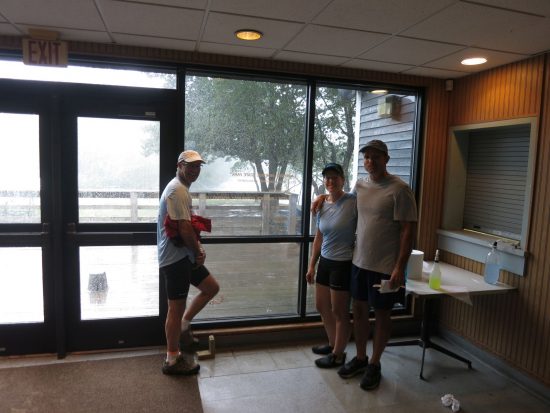
Given the likelihood that the raging waters of the Merrimack would soon sweep us all away, the gang was remarkably cheery.
Within fifteen minutes, the squall had passed through with no damage. With the radar showing no significant threats heading our way, racers started launching their boats and massing for the on-water captains meeting. In a rush to join them, I tucked my GoPro (which I call GP – short for George Parker) in my PFD pocket, grabbed the V14 from the car, and waded into the river. I had intended to mount the camera on my boat during launch, but in the adrenaline-fueled excitement, I found myself up the river without GP saddled. Was that a groan I heard? Hey – nobody is forcing you to read this.
Let’s skip ahead and get right to the important lesson I learned a few moments later. It’s actually two lessons. First, that I’m 90% bonehead. Preaching to the choir on this point, doubtless. Second, that everything Archimedes said about GoPros was indeed true. They do lack sufficient volume to displace a weight of water equal to or greater than their own mass. And they should always be tethered.
As an unblinking witness (and inveterate blabbermouth), GP has captured (and heartlessly disseminated) many of the more thrilling (and humiliating) moments in my life. Although we often locked horns over what was appropriate for public consumption, I was saddened to think of my friend documenting his final frames from the forgotten depths of the Merrimack. The cosmic irony of not being able to broadcast this particular blunder would not be lost on him. Some time after the race was over and we perhaps were enjoying lunch, the fight to carry on would just be too much for GP. Battery exhausted, his recording indicator light would courageously flash until the dark curtain fell at last. Blink… Blink… Blink… The rest is silence.
[I’m going to leave an open space here so that I can insert a jubilant coda when GP is ultimately dredged from the river and returned to me in 2087.]Shaking off my recent misfortune (after all, it only ranks about 7th on this season’s pre-race bloopers), I surveyed the field of 25+ skis. Chris Chappell had brought a shiny new toy to the race – one of the first reinvented Nelo 560s to find its way to the Americas. Designed to slip between individual water molecules, the boat is ridiculously tiny. Chris spent most of the morning looking for it after inadvertently setting the boat in the grass near his car without first activating its locator beacon. Despite its meager 18′ 4″ length, all reports indicate that the 560 is as fast as a grown-up ski. I figured this made Chris my biggest threat.
I also had to be concerned about the Human Alphabet, Andrius Zinkevichus. If his muscular build, imposing accent, and 32 point Scrabble surname weren’t intimidating enough, the guy can paddle. I had beaten Andrius at the Nahant Bay Cup a few weeks earlier, but that was on choppy ocean waters. This time, he’d be in an ICF boat and in his more natural flatwater milieu. He’d also bulked up since the last race, adding an entire second paddler. David VanDorpe would only be contributing 14 points to their combined total, but his impressive paddling resume would more than compensate. To make matters worse, the duo would start in the heat ahead of me.
The double kayaks, which included Mary Beth (in her first-ever doubles race) and Robin Francis, were sent off first while the skis and ICF boats paced nervously in the on-deck basin. Less than a minute later, we were ourselves underway. Poised atop his micro-ski, Chris jumped to an early lead, with Francisco and Wesley in earnest pursuit. As Francisco told me after the race, since he’s been too busy nobly working to improve the lives of Massachusetts’ veterans to actually train, he sprints at the start so that he can be in the lead pack for at least a little while. That guy… always making the rest of us question whether we add any value to society (when he’s not sending the governor out to settle scores, that is).
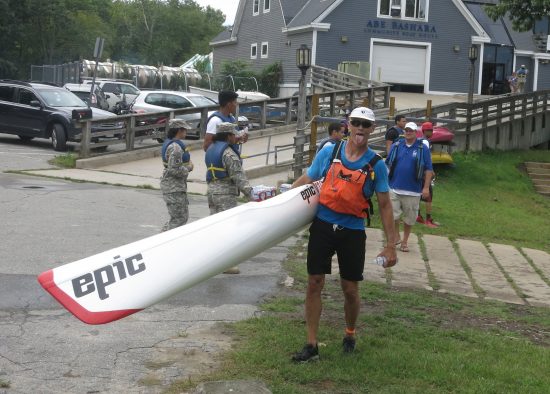
We keep telling Kirk it’s “hands high, chin up, back straight, elbows down”, but all he ever seems to hear is “tongue out”.
After the first few hundred meters, Chris started to pull away from the field. As a member of that field, I took umbrage at the cavalier attitude with which he was abandoning us. No over-the-shoulder cry of “Good luck, chaps!” or wistful look back at his former comrades. I imagined him sneering in contempt ahead. Watching Chris recede over the next few moments, this expression started to sound increasingly appealing. Adopting a pay-it-forward approach, I separated myself from the field with a similarly callous disregard for esprit de corps. I sneered as well, but the only contempt I felt was for [melodramatic pause, followed by breaking voice] myself.
Chris had started out perhaps four to five boat lengths ahead, but I quickly closed the gap to three to five boat lengths, then to two to five lengths. I figured if I left some ambiguity in there, he wouldn’t feel as threatened as I (possibly) crept up on him. When I eventually I reached the lesser end of zero to five boat lengths, there’s was nothing he could do about me snapping concretely onto his stern draft. After resting for a moment or two – the legendary wash that the Bunyonesque Chris provides is notoriously difficult to give up – I reluctantly pulled around to take the lead. Of course, he didn’t take this move sitting down. Extraordinary balance, I must say. He yoked himself behind me and inexplicably shouted out, “Whoa there, Big Blue! Almost got away from me!”
I tried to free myself from Chris’ pitiless grip several times, but he would not be thwarted. When I’ve been pulling someone, I try not to look back too often to ascertain if they’re still there. When the situation is reversed, I always interpret the back-glance a sign of weakness. Sure enough, whenever I succumbed to temptation, I could see Chris smirking at my vulnerability. Well, I couldn’t see much more than a vague shape in my periphery, but since I’ve already started ascribing facial expressions willy-nilly, let’s say he was smirking.
After a mile of this, a quick peek back revealed that I had wiped that smug expression off of Chris’ imagined face. I had finally gapped him. Shortly afterwards, I passed the last of the doubles, excepting Andrius and Dave. They were still toiling well ahead, but I was definitely closing on them. By the time we rounded the upstream end of Pine Island, they were squarely in my sights. Having seen me so close behind at the turn, I figured they’d scramble away rabbit-like and the chase would commence in earnest. They weren’t into playing the prey, however. Like a viper, they reared back as I approached, then sank their fangs into my port draft.
I haven’t mentioned that we had been bucking a headwind on the upstream part of the course. We now enjoyed a stiff quartering breeze behind us. At the next turn of the river, we’d be going dead downwind. Figuring the two boats had roughly the same sail area (that is, one upright paddler silhouette’s worth) but mine had roughly half the weight, that’s when I would try to pry myself loose from the tandem. It was a plan backed up by hard science, but two attempts at super-maximum intensity intervals failed to produce noticeable results. Presumably the guys had set out a jib or spinnaker or something. Finally, on my third attempt, just as I was about to go into the light, I heard a slight pop as Andrius and David disengaged from the draft. Evidently Andrius, stewing in the skirt-covered front cockpit, had overheated and called off the pursuit.
The remainder of the race was painful, but mostly uneventful. Surprisingly, I found the downstream turn-around marker without problems, and wasn’t slammed in the chest by either of the remaining two inflatable turn buoys. As I approached the finish, a roar rose up from the dock. The volunteer kids were cheering me home! Unused to such outbursts from spectators (or, for that matter, spectators), I was quite startled, but managed to stay upright – narrowly avoiding an embarrassing photo finish.
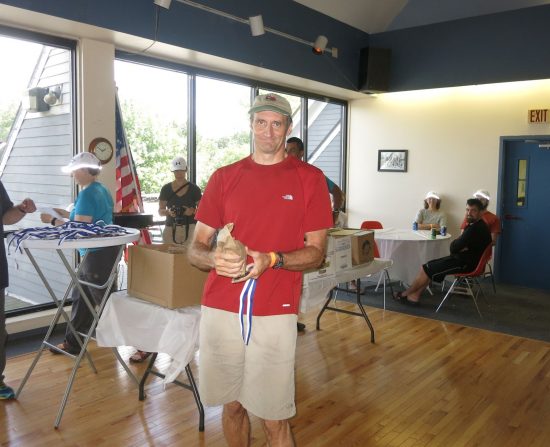
I don’t recall doing multiple tequila shots after the race, but that pose is unmistakable.
Chris finished (grinning, let’s say) in an easy second, with Tim Hudyncia taking third. Kirk Olsen and Bruce Deltorchio rounded out the top five (despite Bruce taking the “No Wake” turn buoy a little too seriously by giving it 75 meters of leeway). Jenifer Kreamer and Leslie Chappell battled the entire race for the women’s lead, with Jen eventually earning the win. Of course, Andrius and David claimed the tandem crown. Afterwards, we enjoyed burgers and dogs while Francisco gave out awards and liberally distributed bags of fruit (to the great disappointment of those of us who were told there were donuts and Twinkies inside). Thanks to the Greater Lawrence Community Boating Program (which should consider adopting a cool acronym, like GLAWCOBOP), and to the many volunteers who made the race possible.
The Lighthouse to Lighthouse is this coming Saturday (register at PaddleGuru by 11pm on Thursday, 9/15). It’s also the East Coast Surfski Championship, with $2,000 in prize money split evenly between men and women paddlers. Is it going to be competitive? Let’s see. Austin Kieffer. Jesse Lishchuk. Reid Hyle. Rob Hartman. Erik Borgnes. Apparently the men’s places start at 6th.
Check out the drone footage from the GSDC.
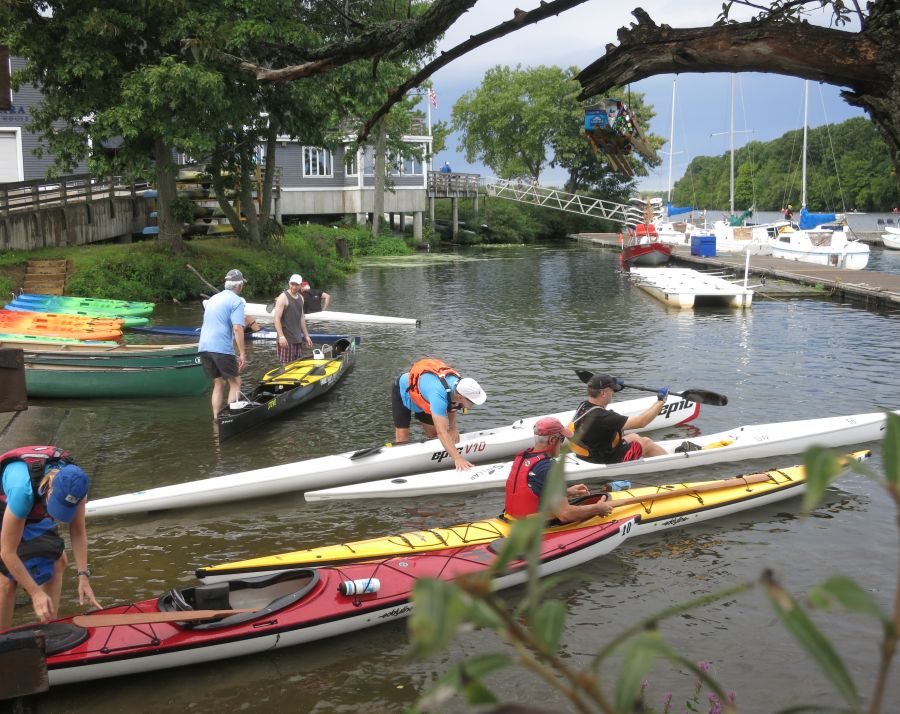
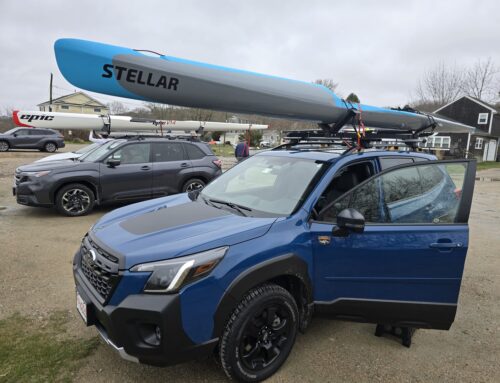
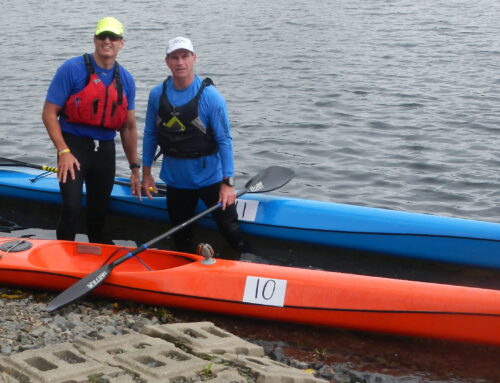
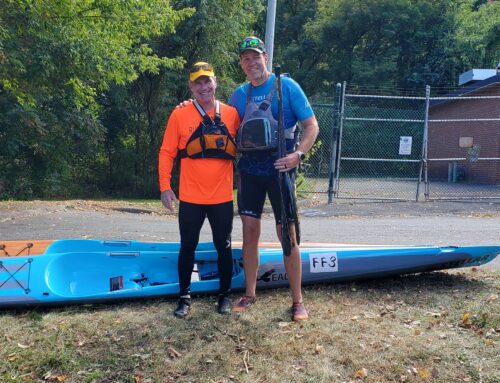
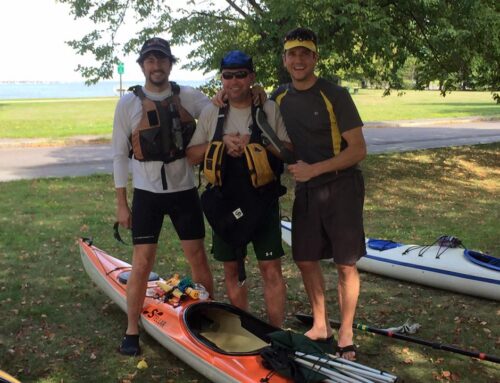
Leave A Comment
You must be logged in to post a comment.